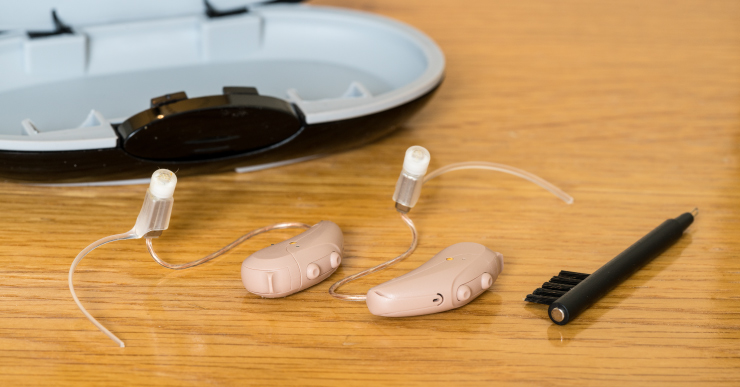More than 1.5 billion people live with hearing loss, who make up 20% of the world’s population. As a health complication, it can be appalling and debilitating. Besides losing one of the most crucial senses, getting used to hearing aids could be daunting for many.
When considering hearing devices, the question arises: are behind-the-ear hearing aids better than in-the-ear options? Among these options, behind-the-ear hearing aids stand out as the most popular choice, excelling in sound amplification while being easily maintainable and wearable. However, similar to any hearing aid, they do have limitations.
In this article, we’ll delve into the specific scenarios where behind-the-ear hearing aids prove most suitable. We’ll highlight their advantages and limitations, empowering you to make an informed choice when selecting the right device.
Let’s explore the intricacies of hearing aids in greater detail.
What Is a Behind-the-Ear Hearing Aid?
As the name suggests, a behind-the-ear hearing aid is worn outside your outer ear. The device’s parts are contained in a plastic case and rest behind the ear. A small tube goes through a narrow inner ear canal that helps the sound travel down into your ear canal.
Behind-the-ear hearing aids are among the most commonly found devices in the market and are considered the most versatile of all types of hearing aids. These aids are helpful in almost all kinds of hearing loss. They are also easy to adjust, clean, and maintain and can accommodate different sizes and shapes of ears. However, they may be more visible and prone to wind noise than other types of hearing aids.
However, one should choose them only after careful consideration and depending on the expert audiologist’s advice.
Are Behind-the-Ear Hearing Aid Better Than In-the-Ear? Notable Pros & Cons

Behind-the-ear hearing aids are usually larger than other hearing aids but have many benefits. For example:
1. Good battery life
Due to their larger size, these hearing aids allow more space for high-capacity batteries. Hence, as compared to other hearing aids, these have better battery life. BTE hearing devices also enhance sound amplification, which is helpful for users with varying degrees of hearing loss, as better amplification can help detect higher frequencies.
2. Easy maintenance
The smaller hearing aids can be difficult to clean and maintain. With these aids, the advantage is that every nook and cranny can be easily cleaned due to its slightly bigger size. The various components of the hearing aid can be removed for cleaning, making it much easier to maintain. Also, the device is placed on the outer ear and is safe from ear wax build-up.
3. Comfortable to wear
These fit nicely on the outer ear and don’t cause any intrusion in the inner ear, making them safe and comfortable to wear.
4. Scope for adding more features
Its bigger size gives space and scope to add additional features to the device, like directional microphones, telecoils, Bluetooth connectivity, rechargeable features, and more.
5. Cost-effective
BTE hearing aids are usually the most budget-friendly of all hearing devices.
Consider These Issues Before Deciding Are Behind-the-Ear Hearing Aids Better than In-the-Ear

Despite their numerous benefits, these may also have some limitations. Such as:
1. Look and Feel
Since these hearing aids are placed behind the ear, they stick out and are more visible than internal hearing devices. However, they come in different variants and are always comfortable to wear.
2. External noise
Since these aids are placed outside the ear, they might pick up a lot of external and background noise, which can be disturbing. For example, users are prone to experience wind noise issues when using these hearing aids in open spaces.
3. Size
For some people, these hearing aids can be cumbersome due to their comparatively bigger size, and they prefer choosing a sleek hearing aid instead. However, you can always choose the best hearing aid for yourself after a visit to our audiologist.
4. Not for people with acute hearing loss
Many users have found that other hearing devices offer better amplification and sound amplification than BTE hearing aids in cases of high hearing loss.
Final Thoughts
Now that you know the outstanding advantages and a few concerns of behind-the-ear hearing aids, you can decide are behind-the-ear hearing aids better than in-the-ear.
However, it is advisable to take the opinion of your physician or the audiologist before investing in any hearing aid to ensure it works best for your particular preferences and conditions.
Centre For Hearing® has 40 years of expertise in providing the best hearing care and aids in the industry. We have a vast network of clinics all over India, including Delhi/NCR, Chandigarh, Maharashtra, Bihar, Jharkhand, and Punjab.
We also provide specialised audiometry tests and a free helpline to address all your concerns and queries related to hearing issues.
Reach us at +91 9811227269 or visit our website to get assistance in managing your hearing health better.


















